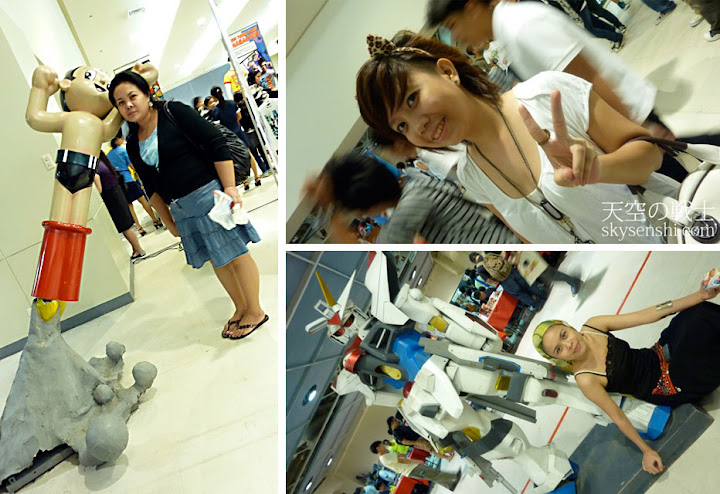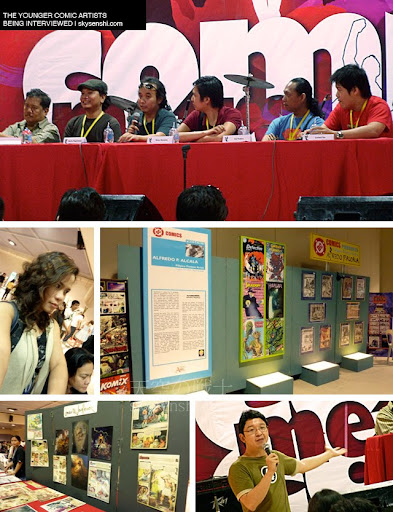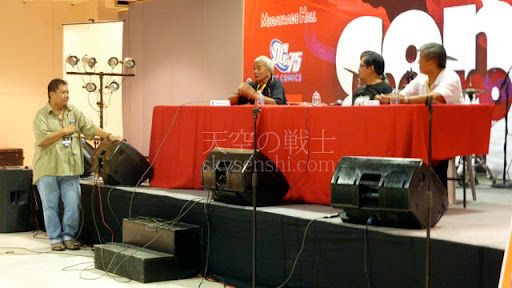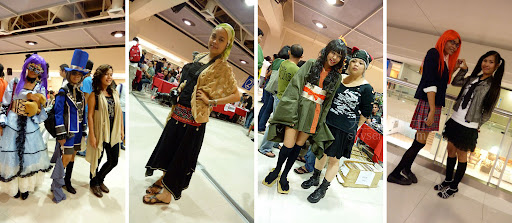Metro Comic Con 2010: A Colorful Venue for Communication Studies
It’s been a long time since I’ve attended a comic convention, but this was my assignment for our Communication Behavior class. (Last Sunday’s Quiapo visit was Rod’s.) We attended the Metro Comic Convention 2010, which was held at the Mega Trade Hall 2 of SM Mega Mall. We were after the cosplayers. Heh.
Here’s a snippet of the primer I’ve written for my final paper:
Internationally, cosplayers belong to a world where grown men can dress up as sexy anime characters, a horizontally-challenged woman can wear skimpy bikinis, and pre-teens can design elaborate robotic getups and thrive in them. Cosplay, which is short for “costume play”, is an activity wherein people from various age groups come together to show off their best costumes – usually based on characters found in animated features or video games. Cosplayers are growing by the number every year, and they are very serious about this activity that it has come down to becoming a craft. It’s an art form that utilizes not only a vivid imagination but also a keen sense of design. A cosplayer must always think of how a fabric can make a costume come to life, as well as how this fabric fits (and molds) a cosplayer’s shape. Then there are issues of colors, as well as accessories. Cosplayers profess that they like to dress up, project through the costumes the character they love, admire or secretly want to be.
The Philippine Cosplay Community is no different from its international counterparts when it comes to honing this craft, but there may be a world of difference in how members interact. A brief interview with one of the first members of the University of the Philippines Anime-Manga Enthusiasts (UP-AME), a globally recognized organization when it comes to animation, comic and toy conventions, spelled the difference. “Papavik”, as the interviewee wants to be called, said that most international cosplayers don’t really know each other on a personal level, since most of them live so far away and that they only come together during conventions. In the Philippines, planned group cosplays are the norm and that these help Filipino cosplayers develop closer bonds. Sometimes these bonds come to the point that it is already difficult to separate the person from the character being portrayed. Papavik says that many Filipino students majoring in artistic fields – namely, Fine Arts or Multimedia Arts – tend to be more meticulous when it comes to costume craftsmanship.
There are three theoretical frameworks I’d like to use in discussing this phenomenon: Jacques Lacan’s Three Orders, George Herbert Mead’s Symbolic Interactionism and Denis McQuail’s Freedom versus Control. I won’t bore you with that discussion on this blog, but I am willing to share my finished paper (on a separate link) with anyone who requests it. =^.^=
Middle: The other kid’s mom is also a cosplayer!!
Most of the cosplayers were outside the venue, since they were already winding down when we arrived. There were a lot of things to see, though. When my classmates and I got inside, we noticed that RJ Ledesma was interviewing the newer Pinoy comic book artists who have worked with Marvel. Well, I wouldn’t exactly call Gerry Alanguilan new, but I love love love his works, especially Wasted.
What they were talking about? Well, basically the same things that we multimedia arts professors always harp on: this industry requires not only talent, but hard work and dedication. Being an artist is not the easy pa-drawing drawing lang life that people in other businesses think. I concur, because I’ve always found programming to be easier than designing.
Later, when RJ Ledesma took his leave, it was Gerry Alanguilan’s turn to act as host and interviewer. This time around, the stage featured three of the old-timers. By that I mean the komiks artists.
I have profound respect for these elders, even though they were griping about how younger artists are now able to hone their creativity better because of the new tools the industry has to offer. I will beg to disagree and my disagreement has a lot to do with my respect for these komikeros’ craft.
I believe our multimedia tools have actually made the new generation of artists lazier. I can count only 2 in every 10 student artists who exhibit the same discipline and dedication that these komikeros possess. Though the older artists were burdened by rules, they learned how to think outside the box in order to let their creativity flow forward. Today, we deal with a set of new rules and these are even deadlier: many artists limit themselves to what a software allows them to do. Too many shortcuts lead to inferior workmanship.
My professor Doc Joey, my classmates and I agree that artists of a time almost gone were more creative because they were more resourceful. They carpentered canvases when there were none, mixed new colors out of a bare minimum of three, used their window panes for drawing 2D in-betweens because they had no light boxes…
Anyway, my classmates and I started walking around to see what else the venue had to offer. And hunt for cosplayers to interview and take photos of. I actually used to cosplay, but I had gained 30lbs in the last two years that I have become too image conscious to don a costume now. Fortunately for us, the younger generation of cosplayers are bolder and more in tune with the characters they cosplay. There is no shame in freedom of expression, so they say.
There’s nothing to complain about anyway, since this is all good, clean fun.
People thought Julienne was a cosplayer and had asked her to pose for them.
Doc Joey had been amused by all the reading material he can find and even bought a few comic books in support of our local comic artists. Rod had too much fun taking photos of toys, while Chitchat…I actually don’t know what she’s doing in some of the booths. Did she contemplate buying some of the gothic Lolita outfits? Hehe.
In any case, Doc Joey was amazed at how the cosplayers have ready poses for the camera. They are not shy. Rod was even surprised to discover that cosplayers will volunteer information before he even asks for an interview. Our activity processing happened at Malate’s O-Bar, wherein we offered several theories about the cosplaying community.
Hm. While I was layouting these photos, I realized that I didn’t have pictures of Rod and Doc Joey at Metrocon (but I had lots of them at Malate, Chitchat’s assignment, which quickly followed mine). The only ones I had of Rod and Doc Joey are at Sbarro, where we ate afterward.









stampychan
August 22, 2010 at 4:25 pmHi! Can you share with me your finished paper about your study at the Metro Comic Con? Thanks!
skysenshi
August 22, 2010 at 4:47 pmHi, stampychan!
Sure! Once I finish the paper (which will prolly be at the end of this first sem), I'll post the link here. I usually do my papers on Google docs so creating a web-friendly version wouldn't be a problem. 😀
acewildgal
August 23, 2010 at 6:05 amHi! I am actually interested in the paper as well. I am a firm believer that pop culture is an interesting study and *should* be studied 🙂 Looking forward and good luck to your paper ^^
skysenshi
August 23, 2010 at 8:54 amHi, acewildgal!
Wow, I didn't know people are interested in the geeky stuff I brew in here. Thanks for dropping by! Will post the link as soon as I am done with it. 🙂